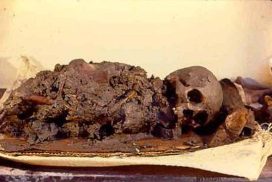

Forensic anthropologist Monica Faraldo employs her passion for bones and puzzles to shed light on ancient migratory routes in the Caribbean.
Monica Faraldo sits in her office surrounded by dozens of bones—from anatomically accurate skulls to cartoonish skeletons to mummy-faced coffee mugs.
It’s hard to imagine her doing anything other than discovering and recovering ancient human remains: For the past 15 years, she’s been analyzing and comparing prehistoric skeletal material from unique cultural burial practices in Costa Rica and Florida.
It was a passion that began during undergraduate coursework at the University of Tennessee in the 1970s, and evolved into a serious hobby and becoming an “armchair archaeologist” while she worked for a data processing firm in Miami. After 16 years in corporate America, Faraldo – encouraged by her daughter to follow her dreams – went back to school.
“I knew that I was going to be analyzing human skeletal remains because that is my passion,” says Faraldo, a lecturer in the Department of Anthropology at the University of Miami College of Arts and Sciences.
She’s now investigating a mystery involving burial patterns that may link ancestors from Costa Rica and Florida who may have migrated through the Caribbean.
About the Photo
Monica Faraldo, lecturer in the Department of Anthropology at the University of Miami College of Arts and Sciences.
Join the Conversation:
Follow on
Twitter:
UM College of Arts and Sciences, @UMCAS
University of
Miami, @univmiami
UM News, @univmiaminews
(Story continues after photo gallery)
Faraldo completed UM’s Bachelor of General Studies program, focusing on physical anthropology, in three years. A year later, she earned a Master of Arts in Liberal Studies from UM, with a boost from an eight-week intensive field experience studying ancient skeletal remains of early hominins, or proto-humans, in South Africa. She’s been teaching courses in physical anthropology, human osteology and forensic anthropology at UM since 2002.
Archaeology examines both human remains and the cultural materials that are associated with those human groups, and then takes those material remains and interprets them to say something about the population. Physical or biological anthropology is the study of humans and their biological relationship to their environment.
Forensic anthropology, Faraldo explains, falls more under physical or biological anthropology because it is primarily human osteology and is the discovery, recovery and analysis of human remains.
The bones she researches are no spring chickens. The newest material Faraldo has examined are human remains that are about 200 years old. The oldest: the remains of the “Taung child” in South Africa, aged more than three million years old.
Typically, however, Faraldo’s research focuses on human osteological material that is thousands of years old. She is currently studying 3,000-year-old material in Costa Rica, the oldest material ever discovered in that country. A rarity, Faraldo points out, because the environmental conditions must be just right for skeletal remains to be preserved there.
“Preservation is not always that great, especially in tropical climates. The environment was just right to maintain them from deteriorating, because even bone will eventually disintegrate away if the context is not appropriate,” says Faraldo. “The pH level was always balanced. Temperature seemed to always stay at a constant coolness and so forth. It preserved them.”
Faraldo, whose father worked in civil aviation, has been visiting Costa Rica from Key West with her family since she was a teenager. Her father’s colleague had a daughter—who would eventually become a cultural anthropologist—similar in age to Faraldo and they became friends. The longtime friendship would ultimately connect Faraldo to a very unique set of ancient skeletal remains in the Central American country.
From the skeletal remains found in La Regla, in the Nicoya peninsula in Costa Rica, Faraldo discovered that the civilization there, at least 3,000 years ago, employed a very unique cultural practice for the deceased—what’s known as a wet burial. After death, Faraldo explains, the community would allow the individual to become completely skeletonized and then create a bundle where they placed the skull inside the torso and the long bones alongside the torso, creating a “nice little packet.”
“They would then wrap it in textile bundles and bury it in an area that had a mucky, muddy consistency, like what you see around mangroves,” says Faraldo.
Faraldo noticed that these wet burials had some similarities to an osteological collection at UM, which has been curated for many years and came from Little Salt Spring, in Florida, about half way between Tampa and Fort Myers on the west coast of the state. She then came across four other groups in Florida—Warm Mineral Springs, Republic Grove, Bay West and Windover—that shared some similar characteristics to the Little Salt Spring and La Regla burial remains.
“That started the questions, ‘What is unique about these six groups? Are there any relationships at the skeletal biology level that would show a shared cultural practice?’” says Faraldo. “As I looked further, I haven’t found any others that practice this same distinctive cultural practice.”
The ancient groups in Costa Rica and Florida were also outliers in their own communities. Around that time, burials in Florida were usually mound-type, Faraldo notes, and the burials in Costa Rica were typically a combination of mound burials and tomb burials.
“Why such a uniqueness?” Faraldo wonders.
Pointing to Central America on a map, Faraldo says, “When you look at how narrow this area is right here, I think of it as a bridge between two large bodies.”
A bridge, she says, that has allowed for humans, over millennia, to maintain relatively constant contact with one another.
“I think we’re finding out more and more that human beings have been extremely mobile for a very long time. It wouldn’t surprise me that the communities were interacting with one another,” says Faraldo.
She notes that these prehistoric populations in Florida and Costa Rica could have easily traversed the Gulf of Mexico and the Caribbean. And, between Costa Rica’s volcanoes and mountain ranges, there are navigable valleys where people could have trekked through from the Caribbean side of the country to the Pacific side, and back.
For her research on the ancient material, Faraldo examined intergroup differences between the five groups in Florida and the one in Costa Rica, as well as intragroup differences for each of the six bundled sets of wet burial remains.
“They all shared very similar cultural traits and that would suggest that maybe there was exchange of information or maybe one group could have been a smaller group that left and migrated away from the larger group,” Faraldo says.
For her analysis, Faraldo studied the morphology of the bones, including the shape and form of the skull, the nasal aperture and the eye orbits. She found that three of the six groups, including the group from La Regla, seemed to be much closer to one another in terms of morphology. Going forward, Faraldo would like to compare DNA testing of the burial remains from the six groups in Florida and Costa Rica for a better idea of their connection to each other.
“I think that there was a lot of movement going on and exchange, not only of genes but exchange of ideas,” says Faraldo.
Though there are nearly a dozen theories of ancient world migration, ranging from the crossing of the Bering Strait to the northern Atlantic migration, none really account for the evidence Faraldo has found by studying these unique ancient burial practices.
“The Atlantic migration theory, it just kind of stops there,” Faraldo says, pointing to just off the eastern coast of Florida on a map. “But there were all kinds of migration that was going on in the Caribbean.”
In her office, proudly showing off old newspaper clippings of archaeological sites and hanging mobiles of faux skeleton heads, Faraldo intrigues you to ask, what’s so cool about bones?
“There’s a certain purity about it. A clarity about it. Bones are hard and tactile and something that you can actually see and measure. It’s also a framework for the individual underneath,” says Faraldo.
Like any good detective work, the more answers you get the more questions you have. The wet burial remains have helped answer some questions for Faraldo, but they’ve spurred a whole other set of questions which she’s attempting to help answer alongside her students.
“It’s a bit more of a challenge to try and answer questions when all you have are just a few skeletal remains of an individual, and I always like a puzzle,” says Faraldo.
- JESSICA M. CASTILLO / UM News



